The Best New Trees and Shrubs of 2024
January 30th, 2024
A hydrangea with dark leaves, a mock orange that reblooms, and an inkberry holly that solves the “bare-legs” problem are among the most interesting new trees and shrubs hitting the market for the 2024 growing season.
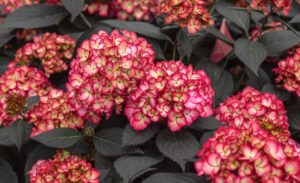
Eclipse is a mophead hydrangea that combines dark foliage with cranberry-colored flowers.
Credit: Bailey Nurseries
Growers, local garden centers, and other plant experts mentioned the following 12 choices for my annual January four-part, best-new-plants series.
Today’s new trees and shrubs make up the final installment of this year’s series.
Part one on best new edibles of 2024 appeared on Jan. 9, part two on best new annual flowers of 2024 appeared on Jan. 16, and part three on best new perennial flowers of 2024 posted last Tuesday, Jan. 23.
Some of the following new tree and shrub varieties are available online and in some plant catalogs. Most also will be available in local garden centers beginning in April.
The details:
Hydrangea Eclipse
This new bigleaf hydrangea in Bailey Nurseries’ First Editions line is being touted as the “first true dark-leaf mophead hydrangea.”
Ryan McEnaney, “Field Guide to Outside Style” author and Bailey communications manager, calls Eclipse an “impressive bloomer and solid garden performer.” But he says what really sets the variety apart is it “has such dramatic and different foliage than any other hydrangea out there. It gives you the opportunity to do something different with one of the most sought-after plants in the world.”
McEnaney adds that the dark-purple leaves hold their color even in warm weather and pair nicely with the ball-shaped, dark-purple to cranberry-colored blooms.
Eclipse turned enough heads at last summer’s AmericanHort Cultivate show that it won a Retailers’ Choice award as a new plant with the potential to become a garden-center best-seller.
It also won the 2024 National Garden Bureau Professional Choice Green Thumb Award as the year’s top new shrub.
Plants grow three to five feet tall and wide, ideally in morning sun and dappled afternoon shade.
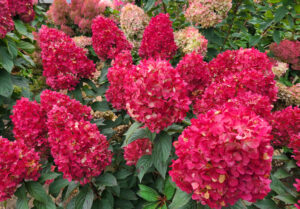
Could Worry Free Ruby Snow be the best panicle-type hydrangea yet?
Courtesy of Overdevest Nurseries
Hydrangea WorryFree Ruby Snow
Lots of superb new panicle hydrangeas have come along in the last 10 years to make this species one of our showiest and easiest-to-grow summer-blooming shrubs. So it takes a lot for yet one more newcomer to make a noticeable dent in an already-impressive field.
Lower Paxton Twp. horticulturist David Wilson, marketing director for Overdevest Nurseries, believes Ruby Snow manages to do that with its huge, sturdy, long-lasting, color-changing flowers that end up in a deep ruby-red color even past frost.
Wilson says the over-sized, cone-shaped flowers start out “gleaming white” in early summer, then take on a soft-pink color, and then intensify into a bicolor bright pink with white tips before morphing into ruby-red by late summer into fall.
“It flowers all over the plant, and it has a tremendously long seasonal display,” Wilson says. “We’ve been testing it for five years and planted it out to compare it with all the major hydrangea panicle introductions. I have come to the conclusion that this is the best panicle selection I have ever seen.”
Besides the flower performance, Wilson adds that the sturdy stems hold the big flowers upright. “It doesn’t flop like many old-fashioned varieties that hang their heads,” he says.
Ruby Snow grows a compact four feet tall and five feet wide and does well in full sun to part shade.
Mock orange Pearls of Perfume
Mock orange is an old-fashioned shrub beloved for one main attribute – its strong, sweet fragrance when the flowers are in bloom for two or three weeks each May. The rest of the year, it’s a nondescript, gangly shrub that sometimes even stops blooming altogether.

Pearls of Perfume is a new mock orange that’s both compact and reblooming.
Credit: Southern Living Plants
Robert Kadas, owner of Highland Gardens in Lower Allen Twp., says the new Pearls of Perfume variety earns mock oranges new attention for two big improvements – much longer bloom and a neater, compact size.
“Pearls of Perfume is the first mock orange to bloom on old and new wood,” he says, “meaning we’ll get to enjoy the pure white, fully double flowers and their wonderful fragrance late spring all the way through summer.”
Kadas says the plant’s habit is compact and upright, growing to about four feet tall and two feet wide, and that the large, pollinator-friendly blooms also make good cut flowers.
Pearls of Perfume is the hybrid creation of Pennsylvania plant breeder Rick Grazzini, owner of Garden Genetics in Bellefonte, Centre County, who has been working on improved mock oranges since 2011. Southern Living Plants is introducing Pearls of Perfume.
It’ll grow in full sun to part shade.
Better Boxwoods
A boxwood-killing blight that showed up in Pennsylvania in 2012 cast a pall over this popular foundation evergreen, leading to a race to find boxwood varieties that are resistant to the fungal disease.

Better Boxwoods is a new series of boxwood selected for resistance to boxwood blight.
Credit: Stewart Perryman
A few existing types such as ‘Little Missy’ and ‘Dee Runk’ have decent resistance, and Saunders Genetics was first out of the gate three years ago with a two-variety NewGen series specifically developed with blight-resistance in mind.
New for 2024 is a second blight-resistant line called Better Boxwoods from the Alabama-based Plant Development Services.
Dubbed “The Blight Fighter” with a super-hero logo, Better Boxwoods are the result of two decades of breeding work and trials in Europe, where boxwood blight hit earlier than in the U.S.
The new line debuts in four varieties: Skylight (a fast-growing upright maturing at about eight feet tall and three to four feet across), Babylon Beauty (a more horizontal type growing about three feet tall and four to five feet wide), Heritage (a rounded shrub that’s slightly taller than wide at four-by-three feet), and Renaissance (a compact variety growing into a two-by-two-foot ball).
The Skylight variety is winner of the 2024 National Garden Bureau Green Thumb Award for best new shrub in People’s Choice voting.
Boxwoods are highly deer resistant and tolerate a wide range of light, from full sun to mostly shade.
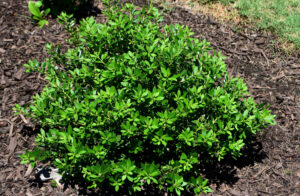
Forever Emerald solves the inkberry-holly bare-legs problem.
Courtesy of Mike Dirr
Inkberry holly Forever Emerald
Inkberry hollies would be a popular and versatile native alternative to disease-threatened boxwoods if they overcame one widespread flaw – a tendency to end up with “bare legs” as they age (i.e. no leaves at the base of plants).
Overdevest Nurseries’ Wilson says Forever Emerald solves that flaw.
“It’s a nice compact grower with dark-green, smaller-than-usual leaves that make it look a bit like a boxwood,” he says. “And most importantly, unlike most of the existing inkberry selections in commerce, it’s well furnished to the ground, which is why our advertising says, ‘Goodbye to ugly legs.”
Plants can grow four feet tall and wide, but Wilson says that “with a little trimming and light maintenance, we believe it will be about three feet in most people’s gardens.”
A bonus is that Forever Emerald produces small white flowers in late spring that bees love. If inkberry males are nearby, the female Forever Emerald will produce small black berries that give the species its inkberry common name.
Plants grow best in full sun to part shade, prefer acidic soil, and are one of the few evergreens that tolerate wet soil.
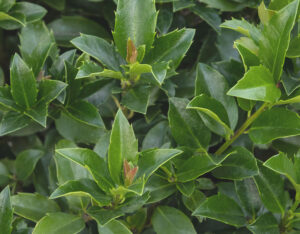
Little One is a blue holly that grows about half the size of a standard blue holly.
Credit: Doreen Wynja, Monrovia.com
Blue hollies are another durable, workhorse evergreen in Pennsylvania gardens, but most of them can grow six to eight feet tall and wide over time.
New for 2024 from California’s Monrovia growers is what’s being billed as the most compact female blue holly yet. LittleOne grows in a compact, rounded habit to only about three feet tall and wide, says Monrovia’s plant selections manager Georgia Clay, who rates the variety as her favorite new shrub of 2024.
“It’s perfect for a low hedge or foundation planting,” Clay says of LittleOne. “And it covers itself in red berries in fall and through the winter, providing wonderful winter color in a small package.”
The female LittleOne needs a male blue-holly pollinator within about 30 feet to set fruit. (‘Blue Prince’ and ‘Blue Stallion’ are two commonly sold males.)
Blue hollies grow best in sun to part shade and in slightly acidic soil.
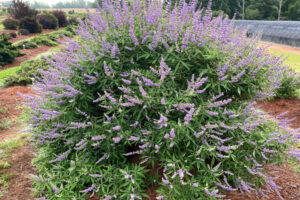
Chastetree Queen Bee is a good alternative to butterfly bush.
Credit: Bailey Nurseries
Chastetrees (also known as vitex) used to be considered borderline-hardy shrubs in the Harrisburg area before our warming winters made this butterfly-bush look-alike a safer bet.
Coinciding with that is the 2024 arrival of a very heavy-blooming new chastetree called Queen Bee.
“This is a great pollinator plant to add to a pollinator garden,” says Ashcombe Farm and Greenhouses nursery manager Brandon Kuykendall, who rates Queen Bee as his favorite new shrub of 2024. “I like that it’s a reblooming vitex, too. And it’s great for dry areas.”
Queen Bee – being introduced under Bailey Nurseries’ First Editions brand – produces long wands of lavender flowers starting in mid-June and then running most of the rest of summer. When in bloom, chastetrees are often mistaken for butterfly bushes – most of which are discouraged these days for seeding invasively into the wild.
Queen Bee plants grow about six feet tall and seven to nine feet wide, ideally in full sun to light shade.
Chastetrees are usually not bothered by deer, bugs, or disease.
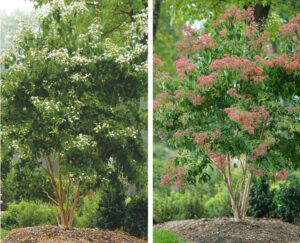
Temple of Bloom is a heavier blooming version of a little known, four-season-interest small tree.
Credit: Proven Winners
Seven-son flower Temple of Bloom
Another new and not-so-well-known plant that’s attractive to bees, butterflies, and hummingbirds is a small tree (or tall shrub, depending on how you prune it) known as seven-son flower (Heptacodium miconoides).
Bryan Benner, a grower at the wholesale Quality Greenhouses near Dillsburg, picks a new variety of seven-son flower called Temple of Bloom as his favorite new woody plant of 2024.
Benner likes the multiple seasons of interest in Temple of Bloom, which includes fragrant white flowers in late summer when most other woody plants are finished flowering for the year, then cherry-red bracts that look like the plant is blooming a second time in a different color, and finally, peeling grayish-white bark for winter interest.
“In my garden, it was covered with flowers and bumble bees,” Benner says. “It has an excellent full habit without much pruning.”
Being introduced by Spring Meadow Nursery under the Proven Winners brand, Temple of Bloom grows to about 10 feet tall and wide in full sun to part shade.
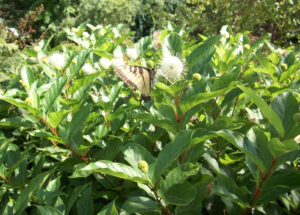
Magical Moonlight is a buttonbush that blooms heavily and is attractive to pollinators.
Credit: Plants Nouveau
Pollinator gardeners also might be interested in this new native buttonbush variety that’s both heavy-blooming and compact.
“(Magical Moonlight) has more flowers and fruits than Sugar Shack, and its compact size allows homeowners to have this tiger-swallowtail butterfly magnet in their smaller space,” says Plants Nouveau co-owner Angela Treadwell-Palmer, who lists this as her favorite new shrub of 2024. “The fruits last most of the winter as well and make for a fourth season of interest.”
Magical Moonlight plants produce hundreds of tubular flowers on rounded flower heads in late spring. That’s when butterflies and many other beneficial insects flock to the fragrant flowers. Waterfowl and birds then feast on the golf-ball-sized round fruits later in summer.
Like other buttonbushes, Magical Moonlight does best in damp to even wet soil, making it a good choice for bogs, pond edges, and other moist environments.
Plants grow about four feet tall and five feet wide, ideally in sites with morning sun and afternoon shade.
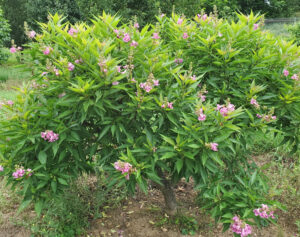
Desert orchid El Nino is a cross between a desert willow and a catalpa tree.
Credit: Proven Winners
If you’re looking for something nobody else in the neighborhood has, check out this new hybrid of two North American native plants – the desert willow and the catalpa tree.
The result of this cross has been dubbed “desert orchid” (botanically “chitalpa”) and Proven Winners is introducing a variety of it called El Nino.
El Nino has pinkish-purple flower spikes that look somewhat like oversized snapdragons. It’s not heavy in the bloom department, but the flowers that it gets are attractive, mildly fragrant, and long-lasting through much of summer.
Plants grow about five to eight feet tall and four to six feet wide, ideally in full to part sun and in good drainage.
El Nino’s winter-hardiness rating is Zone 6 – a level that should make it a reasonably safe match for a “normal” Harrisburg winter.
This one might be hard to find, but if you have deer trouble, desert orchid is a new deer-resistant option worth seeking out.
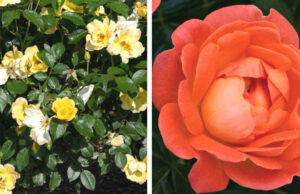
Knock Out rose Easy Bee-zy, left, blooms yellow, while Orange Glow is an orange bloomer.
Credit: Star Roses and Plants
Knock Out roses Easy Bee-zy and Orange Glow
Far more familiar than desert orchid to even half-hearted gardeners is the Knock Out shrub rose, which rates as one of America’s best known and most bought landscape plants.
Chester County’s Star Roses and Plants is adding two new versions to its existing 11-variety Knock Out family in 2024 – a yellow-blooming one called Easy Bee-zy and an orange bloomer with hints of yellow and pink called Orange Glow.
Easy Bee-zy has a bushy, rounded habit of about three to four feet tall and three feet wide. It produces mildly fragrant, soft yellow flowers throughout most of the growing season.
Orange Glow is a bit taller at four-and-a-half feet by three feet and also blooms most of the growing season.
Knock Out roses perform best in full sun but also do reasonably well in part shade.
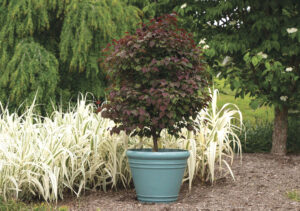
Garden Gems Amethyst is a compact redbud with dark foliage.
Credit: Star Roses and Plants
Redbud Garden Gems Amethyst
Star Roses and Plants is also debuting this new dwarf, dark-leafed redbud that’s compact enough to grow in a pot.
Garden Gems Amethyst is a slow-grower that reaches eight to 10 feet tall and wide – about half the size of a standard redbud.
The combination of the dark foliage and compact size earned Garden Gems Amethyst a Retailer’s Choice award at last summer’s AmericanHort Cultivate show as a plant with the potential to become a garden-center best-seller.
Redbud is also a native tree that’s pollinator-friendly, making it an increasingly popular species lately.
The tree flowers pink in early spring and grows in full sun to part shade.
If you don’t like dark foliage, Star Roses and Plants is introducing a similar-sized sister to Garden Gems Amethyst that has leaves that emerge red and turn green. It’s called Garden Gems Emerald.
Read George’s post on best new trees and shrubs of 2023







